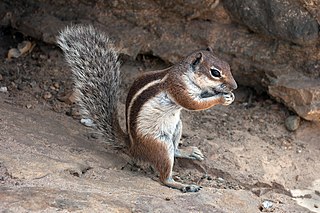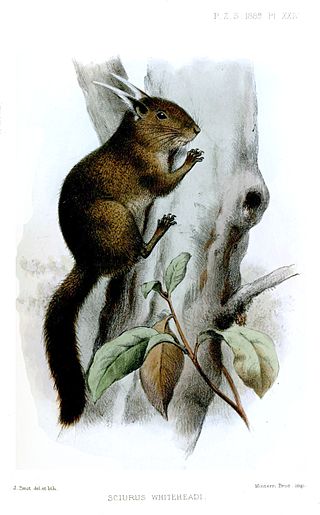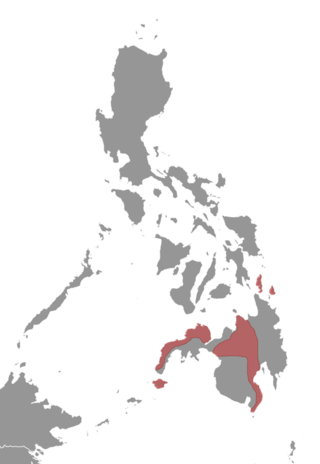
Squirrels are members of the family Sciuridae, a family that includes small or medium-sized rodents. The squirrel family includes tree squirrels, ground squirrels, and flying squirrels. Squirrels are indigenous to the Americas, Eurasia, and Africa, and were introduced by humans to Australia. The earliest known fossilized squirrels date from the Eocene epoch, and among other living rodent families, the squirrels are most closely related to the mountain beaver and dormice.
The red-bellied squirrel or Sulawesi giant squirrel is a species of squirrel. Until recently, it was described as a species in the genus Callosciurus, but since the 1990s it is generally placed in its own genus Rubrisciurus. It is endemic on the Indonesian island of Sulawesi, where it is widespread. It has also been found on Sangir Island to the north of Sulawesi. With a length of 25 cm, it is rather large for a squirrel. It lives in the tree tops of the rainforests of the island.

The Barbary ground squirrel is a species of rodent in the family Sciuridae. It is monotypic within the genus Atlantoxerus. It is endemic to the Atlas mountains in Morocco and some parts in Algeria, and has been introduced into the Canary Islands. Its natural habitats are subtropical or tropical dry shrubland, temperate grassland and rocky areas where it lives colonially in burrows. It was first described by Carl Linnaeus in his landmark 1758 10th edition of Systema Naturae.

The ear-spot squirrel is a species of rodent in the family Sciuridae. It is endemic to Borneo and is diurnal and active mainly in small trees. It closely resembles the plantain squirrel, but is smaller and with a distinct pale buffy patch behind each ear.

The Asian red-cheeked squirrel is a species of rodent in the family Sciuridae. It is found in south-eastern Asia.
The Kashmir flying squirrel is a species of rodent in the family Sciuridae. It is monotypic within the genus Eoglaucomys. It is found in Afghanistan, India and Pakistan. Its natural habitat is subtropical or tropical dry forests. It is threatened by habitat loss. The Afghan flying squirrel is usually considered a subspecies.

The least pygmy squirrel, also known as the plain pygmy squirrel, is a species of rodent in the family Sciuridae. This plain olive-brown squirrel is endemic to forests, mostly below an altitude of 750 m (2,500 ft) but locally significantly higher, on the Southeast Asian islands of Borneo, Sumatra and Banggi. Together with the African pygmy squirrel, the least pygmy squirrel is the smallest squirrel in the world, having a total length of 10–14 cm (3.9–5.5 in) and a weight of 12–26 g (0.42–0.92 oz).

The tufted pygmy squirrel is a species of rodent in the family Sciuridae. It is endemic to highland forest in Borneo. The common name of this tiny squirrel refers to its distinctive ear-tufts. Its diet consists mainly of the lichens and mosses which cover the trees it inhabits.

The northern palm squirrel, also called the five-striped palm squirrel, is a species of rodent in the family Sciuridae. Some authorities recognize two subspecies, F. p. pennantii and F. p. argentescens. It is a semi-arboreal species found in tropical and subtropical dry deciduous forests and many other rural and urban habitats. It is a common species with a wide range and the International Union for Conservation of Nature has rated its conservation status as being of "least concern".

The black-eared squirrel is a species of rodent in the family Sciuridae. It is monotypic within the genus Nannosciurus. This tiny squirrel is found in forests in Borneo, Sumatra and Java. Except for its striking whitish and black facial markings, the black-eared squirrel resembles the least pygmy squirrel.

The Basilan flying squirrel is a species of rodent in the family Sciuridae. It is endemic to the Philippines. It is often confused with the mindanao flying squirrel.
Hagen's flying squirrel is a species of rodent in the family Sciuridae. It is endemic to Indonesia.
The secretive dwarf squirrel is a species of rodent in the family Sciuridae. It is endemic to Sulawesi, Indonesia, where it is found on the Mengkoka Mountains in southeastern Sulawesi. Its natural habitat is montane forest. It is threatened by habitat loss.

The Callosciurinae are an Asiatic subfamily of squirrels containing over 60 species named after the genus Callosciurus, which means "beautiful squirrels".
Kloss's squirrel or Kloss squirrel is a species of rodent in the family Sciuridae. It is endemic to northern Sumatra in Indonesia. Population data is insufficient to assess its conservation status according to the IUCN. It is sometimes considered a subspecies of C. notatus.












